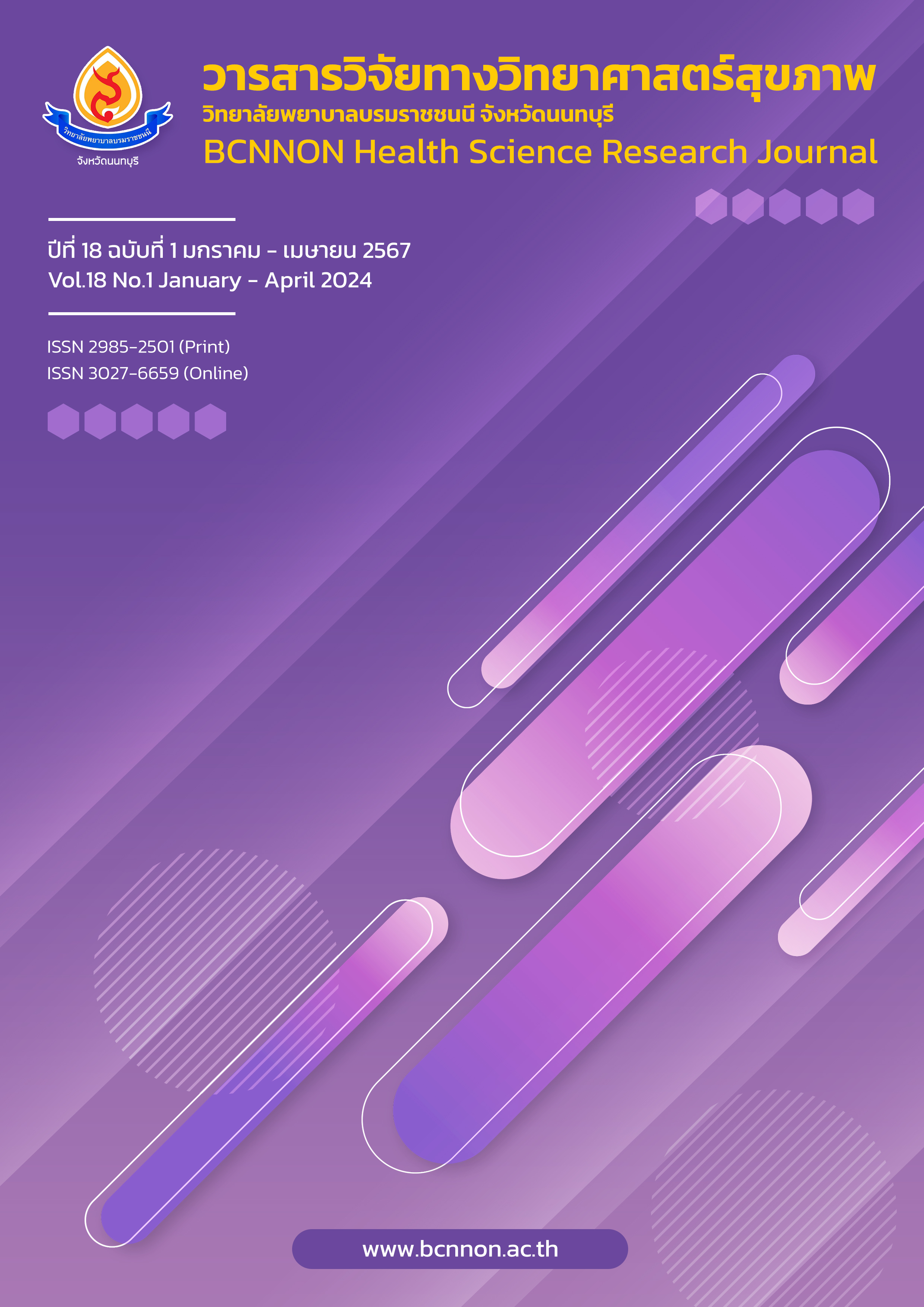Development of media exposure prevention on the pornography model of male teenagers in the 4th Regional Health
Main Article Content
Abstract
Background: Enhancing the understanding of pornography among male teenagers can function as a protective measure against the adverse impacts associated with pornography exposure.
Objectives: To develop media exposure prevention on the pornography prevention model of male teenagers in the 4th Regional Health.
Methods: The research and development study consisted of 3 phases: 1) Studying the situation of media exposure prevention on pornography. The samples were 374 males 15-19 years in the 4th Regional Health, and parents, public health officers, police officers, and one digital officer used in-depth interviews. 2) The developed model was implemented in 40 experimental groups 3) Evaluation of the model of media exposure prevention on pornography. The instrument created by the researcher had a content validity of 0.82-1.00 and a reliability of 0.7. The data was analyzed using frequency, percentage, mean, standard deviation, and independent sample t-test.
Results: The results showed that 1) the situation of using media exposure prevention on pornography of male teenagers had a medium level, 2) the model consisted of seven components as follows: “Media literacy,” “I feel good that not watch it,” “Stand by my Role Model,” “I can control you,” “Uncompromising,” “Seriously” and “Important Persons,” (content validity index: CVI =.96, and Cronbach alpha coefficient = .82), 3)The evaluation of the model found that the experimental group had higher and higher protection against exposure to pornographic media than the control group with statistical significance at the .05 level after the experiment.
Conclusions: The model developed can be used effectively in preventing pornography media exposure among male teenagers.
Downloads
Article Details

This work is licensed under a Creative Commons Attribution-NonCommercial-NoDerivatives 4.0 International License.
บทความที่ได้รับการตีพิมพ์เป็นลิขสิทธิ์ของวิทยาลัยพยาบาลบรมราชชนนี จังหวัดนนทบุรี
ข้อความที่ปรากฏในบทความแต่ละเรื่องในวารสารวิชาการเล่มนี้เป็นความคิดเห็นส่วนตัวของผู้เขียนแต่ละท่านไม่เกี่ยวข้องกับวิทยาลัยพยาบาลบรมราชชนนี จังหวัดนนทบุรี และคณาจารย์ท่านอื่น ในวิทยาลัยฯ แต่อย่างใด ความรับผิดชอบองค์ประกอบทั้งหมดของบทความแต่ละเรื่องเป็นของผู้เขียนแต่ละท่าน หากมีความผิดพลาดใด ๆ ผู้เขียนแต่ละท่านจะรับผิดชอบบทความของตนเองแต่ผู้เดียว
References
Pinyaphong J, Hattha J, Sarnsu N, Thongdee S. Pornography media behaviors among youths. The Golden Peak: Humanity and Social Science Journal. 2020;26(2): 41-50. (in Thai).
Kotain K, Vatanasomboon P, Sompopcharoen M. Factors associated with exposure to sexual content on social media among senior high school students. Journal of Health Science. 2021;30(2):211-22. (in Thai).
Suwannaphant K, Khottarin S, Kansin S, Vonok L. Health literacy factors associated with risk behaviors in HIV infection among high school male students, Bueng Kan Province. Journal of the Office of DPC 7 Khon Kaen. 2019;26(2):71-82. (in Thai).
Department of Disease Control. Situation. Nonthaburi: Department of Disease Control, Ministry of Public Health; 2022. (in Thai).
Muanphetch C, Maharachapong N. Social media usage behavior and sexual intercourse among Thai adolescents. The Journal of Prapokklao Hospital Clinical Medical Education Center. 2020;37(3):232-9. (in Thai).
Suksomsot P, Pumpruek P. The impact of using social media to change the Thai values of teenagers in Phranakhon Si Ayutthaya Province. Journal of Ayutthaya Studies. 2021;13(1):119-37. (in Thai).
Adarsh H, Sahoo S. Pornography and its impact on adolescent/teenage sexuality. J Psychosexual Health. 2023;5(1):35-9. doi: 10.1177/26318318231153984.
Ajzen I. The theory of planned behavior. Organ Behav Hum Decis Process. 1991;50(2): 179-211. doi: 10.1016/0749-5978(91)90020-T.
Maslow AH. Motivation and personality 2nd ed. New York: Harper & Row Publishers; 1970.
Bandura A. Social-learning theory of identificatory processes. In D. A. Goslin, editor. Handbook of socialization theory and research. Chicago, IL: Rand McNally & Company; 1969.
Bloom BS. Learning for mastery. Instruction and curriculum. Regional education laboratory for the Carolinas and Virginia, topical papers and reprints, number 1. Evaluation Comment. 1968;1(2):1-12.
Department of Provincial Administration, Ministry of Interior. Preparation population and housing census. Bangkok: Ministry of Interior; 2021. (in Thai).
Daniel WW. Biostatistics: basic concepts and methodology for the health sciences. 9th ed. Hoboken, NJ: John Wiley & Sons; 2009.
Miles M, Huberman A. Qualitative data analysis. 4th ed. Thousand Oaks, CA: SAGE Publications; 1994.
Andrie EK, Sakou II, Tzavela EC, Richardson C, Tsitsika AK. Adolescents' online pornography exposure and Its relationship to sociodemographic and psychopathological correlates: a cross-sectional study in six European countries. Children (Basel). 2021; 8(10):925. doi: 10.3390/children8100925.
Rothman EF, Daley N, Alder J. A pornography literacy program for adolescents. Am J Public Health. 2020;110(2):154-6. doi: 10.2105/AJPH.2019.305468.
Kholisoh N, Mahmudah SM, Saifudin M. Media literacy among adolescents: preventive to the impact of pornography on social media in South Tangerang. International Conference on Community Development. 2021;3(1):196-201. doi: 10.33068/iccd.Vol3.Iss1.337.
Kantathanawa T. Sexual literacy of adolescents in Thai society. Journal of Social Work. 2015;23(1):1-27. (in Thai).
Sawangsri C, Vatanasomboon P, Powwattana A. Using a mobile health intervention for promoting intention to avoid sexually- provocative media exposure: a pilot study. Thai Journal of Public Health. 2021;51(2): 110-20. (in Thai).
Taikanong K, Chomson S, Nimit-amun N. The factor influencing of the intention of sexual risk behavior amongst high school students. Christian University of Thailand Journal. 2011;17(1):168-77. (in Thai).
Coopersmith S. SEI: self-esteem inventories. 2nd ed. Palo Alto, CA: Consulting Psychologists Press; 1981.


